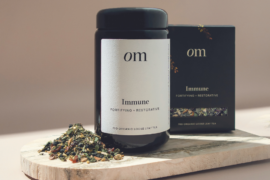Tamarind
Rich in antioxidants, vitamins and minerals, tamarind supports heart health by lowering cholesterol and blood pressure.
Tamarind is a tropical evergreen leguminous tree, a member of the Fabacaea family, native to Africa and India, and today is widely distributed in the tropics. It is long living, grows in a variety of soil conditions and is highly resistant to salt so thrives in coastal areas. Tamarind trees produce an abundance of long curved brown pods filled with seeds surrounded by a sticky pulp that dehydrates to a sticky paste. It has important medicinal properties (cardiac and antidiabetic pharmaceuticals have been produced from this plant), as well as significant industrial uses.
The name tamarind derives from the Persian “tamar-I-hind”, translating as Indian date. Tamarind arrived in Asia in the first millennium BC and it was cultivated in Egypt by 400 BC.
The traditional uses for tamarind include relief from constipation (laxative), abdominal pain, helminth infections, wound healing, malaria and fever, inflammation, cell toxicity, eye diseases, skin rashes (poultice) and neutralising snake venom from bites.
Active ingredients
The seeds contain catechins, procyanidins, caffeic acid, ferulic acid and the polyphenols myricetin, quercetin, apigenin and kaempferol.
Tamarind is rich in nutrients and plays an important role in
human nutrition, particularly in developing countries. Nutritionally, the seeds contain 7.6 per cent protein, 51 per cent polysaccharides, 1.2 per cent fibre, 7.6 per cent oils (oleic acid, linoleic acid (46.5 per cent) and saturated fatty acids (26.4 per cent), along with linolenic, lauric, myristic, palmitic and stearic acids. Tamarind contains B vitamins (particularly B1), choline, Vitamin C and A, and the minerals copper, magnesium, calcium, potassium and iron. Tamarind also contains high levels of tartaric acid (citrus contain citric acid), a powerful antioxidant.
Parts used
The unripe fruit pulp is used in cooking as a souring agent (tartaric acid) in savoury dishes, and as a pickling agent. The ripe pulp is used as a flavouring for chutneys, curries, rice and drinks. It is very popular in India and Pakistan. In the Middle East tamarind is common in meat dishes and often combined with dried fruits (sweet-sour taste). In the Philippines, the whole fruit is made into a soup, sometimes with leaves as well, and the fruit pulp is made into traditional candies. Indonesia makes tamarind soup and mixes the pulp with palm sugar and liquid to make tamarind juice. In Mexico and the Caribbean, drinks and various candies are made from tamarind pulp. In Western cuisine tamarind pulp is found in Worcestershire sauce, HP sauces and barbeque sauce.
Therapeutic uses
Overall tamarind is antidiabetic, antimicrobial, anti-venom, antioxidant, anti-infl ammatory antimalarial, anti-asthmatic, antihyperlipidaemic, antiulcerogenic, wound healing, laxative and hepatoprotective. Every part of the plant — from root to leaf tips is useful for human needs.
Diabetes: Multiple rat studies show the effectiveness of tamarind for managing diabetes and reducing obesity. Its antidiabetic potential was shown through inhibition of α-amylase and α-glucosidase activity producing a post-prandial hypoglycaemic effect; a trypsin inhibitory protein binding to insulin receptors inducing a hypoglycaemic effect and its anti-inflammatory activity reducing damage to pancreatic β-cell activity as some examples.
Cardiovascular: Tamarind leaf and pulp reduced plasma lipids, total serum cholesterol by 50 per cent, non-HDL by 73 per cent, triglycerides by 60 per cent as well as increasing HDL levels by 61 per cent. Activities related to this were reduction of lipid peroxidation, improvement in kidney and liver and increased cholesterol excretion.
Research has shown that tamarind is effective at lowering blood
pressure through various mechanisms, and combined with its anti-inflammatory and antioxidant activity, indicates its importance in the prevention of cardiovascular disease.
Antipathogens: Tamarind has broad-spectrum antibacterial activity against Klebsiella pneumoniae, various Salmonella species, Bacillus subtilis and Staph aureus. It is effective against both gram +ve and gram -ve bacteria and has synergistic effects with some antibiotics.
It also inhibits bacterial biofilm formation. Tamarind is used as an antimalarial in African countries.
Liver: In animal models, tamarind shell was shown to reverse the pathological changes and enzyme disorders caused by excess alcohol on the liver and improved glutathione levels depleted by alcohol. The fruit, pulp, leaves and seeds have shown hepatoprotective and hepato-regenerative activity.
Digestive: Tamarind pulp has multiple uses in the digestive system, the root extract reducing abdominal pain, the ground seeds improving dysentery, the soaked fruit relieving constipation. Reduces fluoride toxicity: Sodium fluoride can be a serious health hazard in humans and chronic intake disrupts carbohydrate, lipid and antioxidant metabolism.
Anti-inflammatory: The anti-inflammatory and antioxidant effects of tamarind have demonstrated improvement in symptoms of arthritis and various cancers, including oesophageal adenocarcinoma, prostate cancer and colorectal cancer.
References available on request




